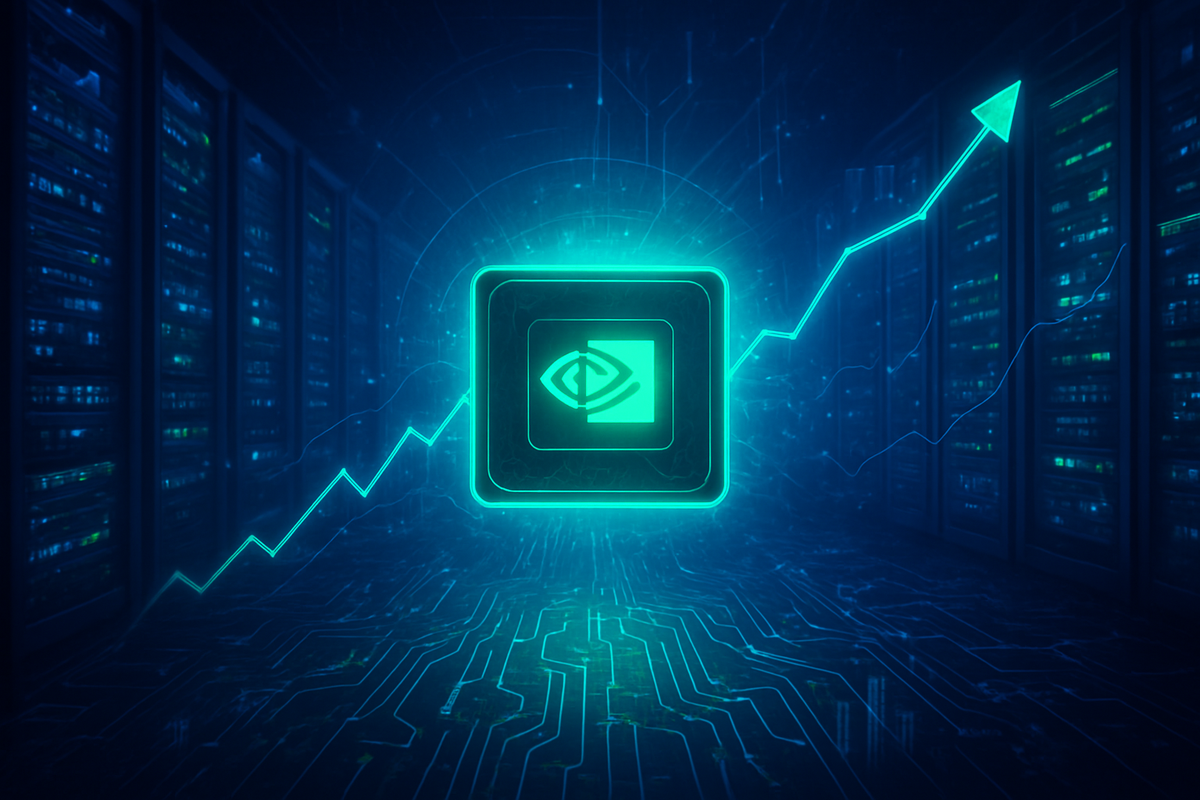
In an unprecedented display of market dominance, NVIDIA (NASDAQ: NVDA) has not only cemented its position as a large-cap titan but has also surged to become the world's most valuable company by market capitalization, reaching an astonishing $4.702 trillion USD as of November 11, 2025. This remarkable achievement, briefly touching $5 trillion in October, underscores the company's pivotal role in the ongoing artificial intelligence revolution and its profound impact on global financial markets. As the undisputed leader in AI chip technology, NVIDIA's trajectory offers a compelling case for investors seeking robust growth in the rapidly evolving tech landscape.
The company's stratospheric valuation and significant influence on indices like the S&P 500, where it now represents a record 8.5%, highlight a transformative period for the technology sector. Driven by insatiable demand for its cutting-edge GPUs and a comprehensive software ecosystem, NVIDIA continues to outpace competitors, setting new benchmarks for innovation and financial performance. Its upcoming Q3 FY26 earnings report, anticipated on November 19, 2025, is poised to further illuminate the depth of its market penetration and the sustained momentum of its data center business, which remains the primary engine of its extraordinary growth.
The Foundation of AI: NVIDIA's Unrivaled Hardware and Software Ecosystem
NVIDIA's commanding position in the AI and data center markets is a testament to its relentless innovation and strategic full-stack approach. As of November 2025, the company maintains an estimated 80% to 94% market share in the AI GPU market, a dominance fueled by its advanced architectures and the pervasive Compute Unified Device Architecture (CUDA) software platform.
The Blackwell architecture, unveiled in March 2024 and widely available in late 2024 and early 2025, stands as a cornerstone of NVIDIA's current success. Successor to the Hopper architecture, Blackwell GPUs like the B200 feature an astonishing 208 billion transistors, engineered specifically for demanding AI workloads, particularly large language model (LLM) inference and training. These chips offer substantial performance gains and energy efficiency, with systems like the GB200 Superchip and GB200 NVL72 rack-scale systems providing up to 30 times more performance than previous generations. Approximately 3 million Blackwell chips have reportedly shipped in 2025, indicating robust market adoption, though U.S. export restrictions have led to the development of lower-specification "B-series parts" for the Chinese market.
Looking ahead, the "Rubin" architecture, poised as Blackwell's successor, is already entering production as of November 2025, with mass production expected by Q3 2026. Rubin GPUs, featuring TSMC's advanced N3P (3nm-class) manufacturing process and High Bandwidth Memory (HBM4), are designed to push the boundaries of AI performance even further. NVIDIA CEO Jensen Huang is reportedly securing a substantial 30% share of TSMC's (NYSE: TSM) 3nm production capacity for these upcoming chips, demonstrating the company's aggressive roadmap which extends to "Rubin Ultra" and "Feynman" architectures in 2027 and 2028.
Beyond hardware, NVIDIA's proprietary CUDA platform is the strategic "moat" that underpins its dominance. CUDA serves as the de facto backbone for AI development, offering a comprehensive ecosystem of optimized libraries and tools that create significant "high switching costs" for developers. This deep entrenchment makes it technically and financially challenging for customers to migrate to alternative hardware, reinforcing NVIDIA's market leadership and enabling its premium pricing power. NVIDIA's full-stack strategy also encompasses AI Enterprise Suite, "AI factory" infrastructure (including the BlueField-4 Data Processing Unit), and strategic partnerships with hyperscale cloud providers like Microsoft (NASDAQ: MSFT), Amazon (NASDAQ: AMZN), Google (NASDAQ: GOOGL), and Oracle (NYSE: ORCL), further cementing its integral role across the AI value chain.
The Ripple Effect: Winners and Losers in NVIDIA's Wake
NVIDIA's pervasive influence in the AI and accelerated computing markets creates a complex landscape of opportunities and challenges for a diverse array of companies. Its cutting-edge hardware and the entrenched CUDA ecosystem dictate the competitive dynamics, leading to both strategic partnerships and formidable rivalries.
Among NVIDIA's direct competitors, Advanced Micro Devices (NASDAQ: AMD) stands as the primary challenger in both gaming and AI accelerators with its Instinct MI series. While AMD's MI350 Series aims to deliver significant AI compute performance, it still grapples with NVIDIA's market share and the less mature ecosystem of its ROCm software platform compared to CUDA. Intel (NASDAQ: INTC) is also ramping up its AI chip efforts with Habana Labs' Gaudi accelerators and is a key player in the UXL Foundation, an initiative seeking to build an open-source software suite to challenge CUDA's dominance. However, Intel faces the uphill battle of overcoming NVIDIA's established lead and ecosystem lock-in.
Interestingly, some of NVIDIA's largest customers are also emerging as significant competitors. Hyperscale cloud providers like Google, Amazon Web Services (AWS), and Microsoft Azure are heavily investing in developing their own custom AI silicon, such as Google's Tensor Processing Units (TPUs), Amazon's Trainium and Inferentia chips, and Microsoft's Maia chips. This vertical integration aims to reduce reliance on NVIDIA, optimize costs, and tailor chips for their specific cloud workloads. Broadcom (NASDAQ: AVGO) has also emerged as a formidable challenger in custom AI Application-Specific Integrated Circuits (ASICs) and networking components, with its custom XPUs offering superior efficiency for AI inference tasks for hyperscalers like Meta Platforms (NASDAQ: META).
On the partnership front, cloud service providers benefit immensely from integrating NVIDIA's latest GPUs, including Blackwell-powered instances, into their infrastructure, offering cutting-edge AI computing to a wide range of customers. System integrators like Oracle and Hewlett Packard Enterprise (NYSE: HPE) collaborate with NVIDIA on large-scale AI systems, such as the U.S. Department of Energy's (DOE) Solstice supercomputer. Telecom companies like Nokia (NYSE: NOK) and Deutsche Telekom (OTCMKTS: DTEGY) are also partnering with NVIDIA to develop AI-RAN products and sovereign Industrial AI Clouds. While these partnerships drive innovation and market expansion for all involved, they also highlight the increasing dependence on NVIDIA's technology, which can lead to significant procurement costs and potential supply chain vulnerabilities. NVIDIA's expansion into services like DGX Cloud Lepton also creates a delicate balance, as it can be seen as competing with its own cloud partners.
Wider Significance: Reshaping Industries and Geopolitics
NVIDIA's unprecedented market dominance as of November 2025 is not merely a corporate success story; it is a pivotal force reshaping global industry trends, influencing geopolitical dynamics, and drawing significant regulatory attention. Its GPUs and CUDA ecosystem have become the indispensable infrastructure for the AI revolution, making NVIDIA a critical enabler for nearly every sector.
The company's trajectory is deeply intertwined with the proliferation of AI, which has transitioned from a specialized tool to a fundamental technology. By late 2025, AI adoption has become widespread across industries, from healthcare and manufacturing to marketing and creative arts, with generative AI usage nearing 71%. NVIDIA's powerful Blackwell chips are foundational to this expansion, enabling advanced applications from large language models to robotics and autonomous systems, thereby fueling an insatiable demand for its data center products.
A significant emerging trend is the rise of Sovereign AI initiatives, where nations are striving to build independent AI capabilities using local infrastructure, data, and talent. While the goal is to reduce reliance on foreign technology, NVIDIA is paradoxically a key partner in many of these efforts. Examples include Germany's €1 billion "Industrial AI Cloud" with Deutsche Telekom and a $2 billion "Sovereign Artificial Intelligence Center" in Kazakhstan. This trend underscores the strategic importance of AI infrastructure and the complex interplay between national security and technological dependency.
The ripple effects on competitors are profound. Rivals like AMD, Intel, and custom AI chip developers face immense pressure to innovate and break NVIDIA's "moat," primarily its CUDA software ecosystem. While NVIDIA holds a commanding market share, competitors are gaining ground, particularly in specialized niches. The existence of NVIDIA's Inception Program, supporting over 15,000 AI startups, further embeds these companies within NVIDIA's ecosystem, creating a "default by design" dependency.
NVIDIA's multi-trillion-dollar valuation and critical role in AI infrastructure also carry significant regulatory and policy implications. Concerns about market dominance, potential anti-competitive practices, and the concentration of AI development in a few hands are leading to increased antitrust scrutiny in the USA, EU, and China. The US-China tech rivalry directly impacts NVIDIA's business, with export restrictions on advanced AI chips like Blackwell limiting sales to China, a move NVIDIA CEO Jensen Huang has warned could hinder American innovation. Regulators are also increasingly focusing on the ethical deployment of AI, data privacy, and the societal impact of AI's rapid adoption.
Historically, NVIDIA's current position draws parallels to Intel's (NASDAQ: INTC) dominance in the PC era, where it became a foundational technology provider for a new computing paradigm. The current "AI infrastructure arms race" is often compared to the early days of cloud computing, but with "exponentially higher" stakes due to AI's transformative potential. These historical precedents highlight the long-term impact of such technological consolidations on industry structure and future innovation.
The Road Ahead: Navigating Opportunities and Challenges
As NVIDIA continues its reign as the AI kingpin in November 2025, the road ahead is paved with immense opportunities driven by an expanding AI market, yet shadowed by intensifying competition and geopolitical complexities. The company's strategic foresight and adaptability will be crucial in shaping its future trajectory.
In the short term (1-2 years), NVIDIA is expected to maintain its leadership in AI infrastructure. The demand for its Blackwell and the upcoming Rubin architectures will continue to fuel significant data center growth, with Blackwell sales projected to reach tens of billions in 2025 and 2026. However, immediate challenges include the impact of U.S. export controls on advanced AI chips to China, which could result in billions in lost revenue and accelerate China's domestic semiconductor industry. Supply chain bottlenecks, particularly for NVLink switch components, and customer concentration also present vulnerabilities. Concerns about "double-ordering" and a potential cyclical downturn in revenue starting in 2026 are also on analysts' radars.
Looking at the long term (3-5+ years), NVIDIA is poised to expand its influence beyond core AI accelerators into new frontiers. This includes deeper dives into robotics, edge AI, and autonomous systems, leveraging its GPU technology and AI expertise to power intelligent machines. The company is heavily investing in "Physical AI," aiming to be present in every facet of the AI robotics market, from training models (e.g., Gr00t N1) to creating simulation environments. Strategic alliances in quantum computing also position its ecosystem for future hybrid systems. The global AI infrastructure market is forecasted for explosive growth, with NVIDIA expected to retain a dominant market share in AI-focused GPUs.
To maintain its dominance, NVIDIA will need to continuously adapt its strategy. This includes relentlessly innovating its hardware architectures, further enhancing the CUDA software ecosystem to maintain its developer lock-in, and diversifying into new market segments like robotics and reasoning AI. Navigating geopolitical risks will require developing specialized, less powerful chips for restricted markets and participating in "Sovereign AI" initiatives.
Competitors, in turn, are actively pivoting their strategies. AMD (NASDAQ: AMD) is leveraging its open-source ROCm platform to challenge CUDA, while Intel (NASDAQ: INTC) is investing heavily in its Gaudi processors and the UXL Foundation, which seeks to create open-source alternatives. Hyperscale cloud providers like Google, Amazon, and Microsoft are developing their own custom AI silicon to reduce reliance on NVIDIA, optimize costs, and tailor chips for their specific cloud workloads. This delicate balance means NVIDIA's biggest customers are also becoming its biggest competitors.
Emerging market opportunities include the shift towards Reasoning AI and agentic AI, robotics, edge AI, and the burgeoning "Sovereign AI" initiatives. The generative AI market is projected for explosive growth beyond current applications. However, significant challenges loom, notably the dramatic increase in energy consumption by AI data centers, geopolitical shifts, ethical AI concerns, and a global talent scarcity. Some analysts also caution about potential "bubble territory" in AI valuations and a possible "trough of disillusionment" in the coming years.
Potential scenarios and outcomes range from NVIDIA maintaining its dominance through continuous innovation and strategic diversification, to increased competition and market share erosion as open-source alternatives gain traction and specialized hardware proliferates. A significant impact of geopolitical factors could also lead to a bifurcation of the global AI hardware market.
The Unfolding AI Narrative: NVIDIA's Enduring Influence
NVIDIA's journey to becoming the world's most valuable company by market capitalization is a testament to its visionary leadership and relentless innovation at the heart of the artificial intelligence revolution. The company's strategic foresight in developing powerful GPU architectures like Blackwell and the upcoming Rubin, coupled with the unparalleled stickiness of its CUDA software ecosystem, has created a formidable moat around its dominance in AI and data center computing. This integrated hardware-software strategy not only enables groundbreaking advancements in generative AI, scientific research, and industrial automation but also positions NVIDIA as an indispensable infrastructure provider for the global digital economy.
Looking ahead, NVIDIA is navigating a complex landscape of immense opportunities and significant challenges. While the insatiable demand for AI, the burgeoning fields of robotics and reasoning AI, and global "Sovereign AI" initiatives promise continued growth, the company must contend with intensifying competition from AMD (NASDAQ: AMD), Intel (NASDAQ: INTC), and hyperscalers developing custom silicon. Geopolitical tensions, particularly U.S. export controls, and the escalating energy demands of AI data centers represent critical hurdles that will require strategic adaptation and diversification. Investors should closely monitor NVIDIA's Q3 FY26 earnings report, its progress in new market segments like physical AI, and its ability to maintain its software advantage amidst growing calls for open-source alternatives.
Ultimately, NVIDIA's story is more than just a corporate success; it is a defining narrative of the AI era. Its innovations are not merely driving technological progress but are reshaping industries, influencing national strategies, and pushing the boundaries of what is computationally possible. While the market may experience periods of volatility and increased competition, NVIDIA's foundational role in accelerating intelligence ensures its lasting impact on the future of technology and the global economy.
This content is intended for informational purposes only and is not financial advice





